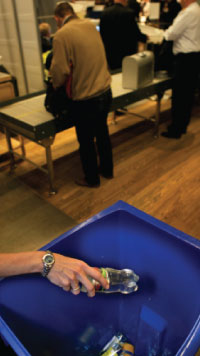
ACI EUROPE has been collaborating with its European contacts, in particular ECAC, to conclusively establish the viability of all LAGs screening devices currently available on the market, and the relevant implications.
LAGs are a banner issue for airports – the rule has redefined passenger perception of the airport experience. Passengers now worry just as much about the time required to pass through security, as the time required to check-in for their flight. With the April 2011 date for the initial easing of the LAGs restrictions looming fast, ACI EUROPE has been stepping up its efforts on this important issue, expressing deep concerns about the readiness of the technology and the steps necessary for proper implementation.

LAGs are a banner issue for airports – the rule has redefined passenger perception of the airport experience. Passengers now worry just as much about the time required to pass through security, as the time required to check-in for their flight.
Some laboratory tests have been carried out on the currently available technology organised by the European Civil Aviation Conference (ECAC) and in October, it made the results of those tests available to Civil Aviation Authorities across the European Union. ACI EUROPE has repeatedly stated its concerns that the current available technology is not mature enough to be relied upon at present and that other factors including operational testing, certification, production, procurement, installation, infrastructure modification as well as training timelines have not been given appropriate consideration. Moreover, the potential impact on passenger screening processes and airport operations has not been adequately analysed. In addition, major European trading partners – in particular the US – have yet to indicate whether they will accept the removal of the restrictions.
These factors mean that the April 2011 deadline has the potential to cause huge confusion and disruption for both airports and their passengers. ACI EUROPE is working closely with other stakeholders to ensure that EU decision makers are armed with as much information as possible, in view of the potential effect on airport operations, passenger experience and flight punctuality.
ACI EUROPE has been collaborating with its European contacts, in particular ECAC, to conclusively establish the viability of all LAGs screening devices currently available on the market, and subsequently to publicise these findings. The trade body also presented to the EU Stakeholders Advisory Group for Aviation Security (SAGAS) on November 24th on the issue. SAGAS is organised by the European Commission and is attended by Member States and other aviation industry stakeholders and represents an excellent opportunity to inform decision makers on the issue.
Within the European Parliament and among national authorities, there is a growing appreciation of the concerns raised by Europe’s airports, that without appropriate and mature, fully certified technology in place, the lifting of the LAGs ban has more potential to complicate the passenger experience than improve it. This is an issue of both importance and urgency, with a potentially direct and disruptive impact upon daily airport operations across Europe. The next issue (Spring 2011) of Airport Business will bring you the final update on this issue. While ACI EUROPE will continue to track this issue and keep its members informed, in the meantime, those with concerns and enquiries should contact their national authority.







